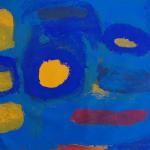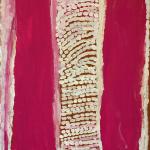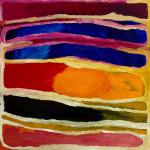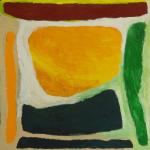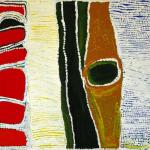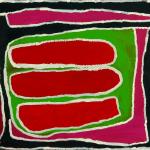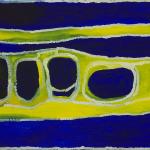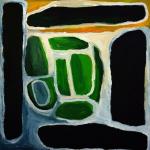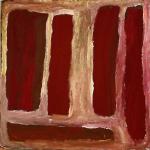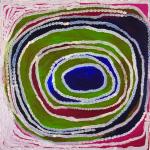Kumanjayi [deceased] Surprise was a highly regarded, award-winning contemporary artist known for her uninhibited painting style. She was born at Tapu in the Great Sandy Desert circa 1929. Before Kumanjayi Surprise passed away, she told this story:
Tapu is my father’s country and Kurtal is my mother’s country. My parents died when I was a baby. I grew up at Wayampajarti and that is my country now. I don’t remember my mummy or daddy. They passed away in the desert. When I was crawling my sister-in-law Trixie took me to Christmas Creek. I was promised to one old man who had two wives. We had no clothes when we went in. We were frightened of the Station Manager so we ran away from that place. Two times we ran away to the desert.
I walked out from the bush as a young woman with my two brothers. We were living at Wayampajarti and the surrounding country. At Wayampajarti there is a jila [permanent waterhole] where Kalpartu [an ancestral snake] lives. When we lived out in the bush we learnt the law. We learnt where the water is, where our country is and where to find food. You have to be careful not to go to the wrong places because you might make the Kalpurtu [spirit snake] angry or them other ones like Kukurr, Murungkurr, Parlangan. You could make other people angry too. You need permission to go to other people’s country.
I went to the desert with my husband to look for kumanjayi [deceased] Skipper out there, then we all came back for ceremony. My husband worked as a contractor building fences and I travelled with him. I worked as a camp cook. I cooked food for big mobs of people. I also cleaned and milked goats. We worked at Quanbun Downs, Jubilee Station, Yiyili and Cherrabun Station. Then I lived mainly at one place, GoGo Station (near Fitzroy Crossing) until I was old. I came to Fitzroy Crossing in the 1950s. I have a big mob of kids and some of them have passed away now.
I first started painting at Karrayili Adult Education Centre in the early eighties. We told our stories through painting and learned to speak to English like kartiyas [Europeans]. I also painted at Bayulu community near Fitzroy Crossing. That’s how I told my story to kartiya. We worked on paper then, not canvas or board.
When I paint, I think about my country, and where I have been travelling across that country. I paint from here (points to head - thinking about country) and here (points to breasts, collarbone and shoulder blades - which is a reference to body painting). I think about my people, the old people and what they told me, and jumangkarni [Dreamtime]. When I paint I am thinking about law from a long time ago. I like painting. I get pamarr [rock, stone money] for it. I can buy my food, tyres and fix my car. I give some money to my family and I keep some for myself.
Nobody taught me how to paint. I put down my own ideas. I saw these places for myself when I went there with the old people. I paint jilji [sand hills], jumu [soak water], jila [permanent waterhole], jiwari [rock hole], pamarr [hills and rock country], I think about mangarri [vegetable food] and kuyu [game] from my country when I was there.
Links
http://www.artcollector.net.au/WakartuCorySurpriseTheWorldAccordingtoWakartu
http://au.news.yahoo.com/thewest/a/-/wa/7678387/kimberley-painters-snare-top-art-prizes/
http://www.artshub.com.au/au/news-article/news/visual-arts/western-australian-indigenous-art-awards-181851
http://au.news.yahoo.com/thewest/full-coverage/chogm-2011/a/-/article/7712506/kimberley-women-big-winners/
Wakartu Cory Surprise
Painting Themes:
Ngarrankarni (Dreamtime) stories
Parrjalpartu (mother and father’s country)
Mayita (mother and brother’s country)
Tapu jila (permanent waterhole)
Pamarr (hills and rock country) in Wayampajarti country
Jila (permanent waterhole) from Wayampajarti and surrounding country
Jilajiwari (rockholes)
Ceremonial jiwari (rock hole) in Wayampajarti
Jilji (sanddunes) from Wayampajarti and surrounding country
Awards:
2010: WA Indigenous Art Award
2009: Western Australian Premier’s Indigenous Art Award Winner of the ‘WA $10,000 Artist’ Award
2008: 25th Telstra National Aboriginal & Torres Strait Islander Art Award Highly commended
1997: 14th Telstra National Aboriginal & Torres Strait Islander Art Award Winner of the ‘Telstra Work on Paper’ Award
Collections:
National Museum of Australia
National Gallery of Australia
National Gallery of Victoria
Art Gallery of New South Wales
Charles Darwin University
Steve Luzco Collection, San Franciso, USA
Sammlung Alison and Peter W Klein Collection, Germany
Laverty Collection
HBL Collection, Melbourne
Harriett and Richard England Collection
Fitzroy Crossing High School
Fitzroy Crossing Hospital
Exhibitions:
2009: Broome Prison - Panel design project
2008: Fitzroy Valley Education Centre – panel project
2008: Fitzroy Hospital - Wall design project, paintings on canvas, nurse base floor design



